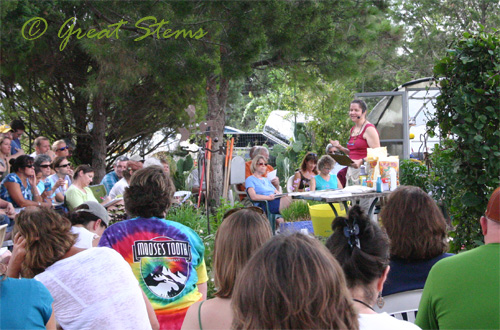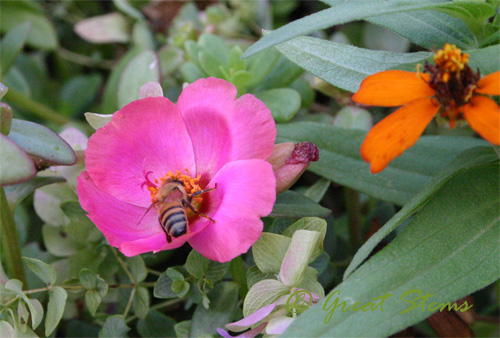I’m a bit behind in reporting on what I learned at the Organic Vegetable Gardening 101 class at Natural Gardener on Saturday. We’re painting our house, and it takes a very long time, as we’re doing it by ourselves using brushes only. Oh, how my muscles ache. Give me weeding and tilling over exterior painting any day! On the other hand, it’s looking good, despite the slow method! I’ll share a picture at some point, when we’re further along in the process.
So… veggies! By the way, I took this class with Caroline of The Shovel-Ready Garden and Cat of Amlo Farms. They are delightful! I see in Caroline’s blog that while I took more notes, she took more pictures, haha! Well, I’m a farming newbie — I had to pay close attention! So I recommend visiting Caroline’s blog for additional information about hoop houses and many excellent photographs.
 The class, taught by horticulturist Rosina Newton, covered a lot of the basics of starting a garden. A big part of her lecture was on soil preparation. It was particularly interesting to hear how much they mix into their soil, versus the simple mixing in of compost that I did for my jack-o-lantern pumpkins. For their vegetable garden, they mixed in:
The class, taught by horticulturist Rosina Newton, covered a lot of the basics of starting a garden. A big part of her lecture was on soil preparation. It was particularly interesting to hear how much they mix into their soil, versus the simple mixing in of compost that I did for my jack-o-lantern pumpkins. For their vegetable garden, they mixed in:
-
cottonseed meal (organic 7-2-1 fertilizer)
-
cow manure compost
-
green sand (for minerals, such as potassium)
-
worm castings
-
*crab shell (*they are dealing with root-knot nematodes, which are bad nematodes – the crab shell encourages chitin-loving microbes to increase, which will consume both the crab shell and the bad nematodes)
They also water in with liquid seaweed and then regularly fertilize. In Texas, we need to mulch – pine straw is recommended. Rosina says, “Never leave bare soil.”
Rosina recommends fertilizing every 4 to 6 weeks with an organic fertilizer. Fertilizers are labeled with three numbers, which in order identify ratio of Nitrogen : Phosphorus : Potassium (N-P-K). FYI, they are absorbed in a 3-2-1 ratio. Nitrogen helps with green leafy growth; phosphorus helps with roots, blooms, and fruit; and potassium helps with plant vigor, stem strength, and disease/pest resistance. For my pumpkins and melons, I chose Rabbit Hill’s Buds ‘N Blooms fertilizer. So if you never knew what those numbers mean, there ya go! Choose your fertilizer based on your garden needs.
Other tips:
-
Add Innoculant when planting legumes, for necessary rhizobium bacteria.
-
Plant your garden east to west to allow best sun coverage as it passes over. Taller plants should be on the north side, unless you need them to provide shade for other plants.
-
Don’t over-till. A garden fork is preferable over a shovel, too.
-
Always wet the root ball before transplanting.
-
Always rotate your crops with each planting season. For example, don’t use the same bed you just had squash in to plant anything else from the squash family. Ideally, wait two years before using that same location.
There was other information about dealing with clay soil, sheet mulching to deal with Bermuda grass, and using row and shade cover. I’m not adding that here, but if anyone is interested in what was said, I’ll be happy to provide it if you let me know in a comment.
Here’s a bee that captured my attention while they were planting during class. I love bees!
 This was an interesting side note from Rosina – apparently it has been found that ADD/ADHD is linked to a magnesium deficiency. And what is the first nutrient to deplete from the soil? Magnesium. Could there be a correlation in regard to diet, she wondered? In any case, it certainly won’t hurt to make sure your veggies and fruits get fertilized and replenished minerals. Epsom salt adds magnesium, fyi. Apparently there’s info on the package about how to use in a garden.
This was an interesting side note from Rosina – apparently it has been found that ADD/ADHD is linked to a magnesium deficiency. And what is the first nutrient to deplete from the soil? Magnesium. Could there be a correlation in regard to diet, she wondered? In any case, it certainly won’t hurt to make sure your veggies and fruits get fertilized and replenished minerals. Epsom salt adds magnesium, fyi. Apparently there’s info on the package about how to use in a garden.
With trusty Googling, I read that symptoms of low magnesium include light or restless sleep and daytime sleepiness. That’s me to a tee – I’ll need to see what my energy levels are like on days where I do or do not eat nuts, spinach, oatmeal, or bananas.
A final note — Rosina’s helper added this message, which I’d like to pass on: “Teach children and others to be caretakers of the soil, for the next generation.” So many kids never venture outside, much less learn to garden, in this era of technology. How will they protect the Earth, if we don’t teach them to love it and nurture it?
There’s a Master Gardeners organic gardening class on Saturday. I might try to go to it, too.
OH, I’m so glad you took such good notes – you got all the nuggets of info that slipped my mind (and weren’t on the handouts). I came totally unprepared for notetaking – my pen stopped working, and I had no paper except for the page you loaned me! I am bringing a NOTEBOOK next weekend! (Love your bee pic!)
I apologize for forgetting to email you back an answer to your question about vegy varieties. I didn’t recognise any of the ones you had. My favorite cuke is Armenian. It is very sweet and lasts much longer in the heat then any others. My favorite tomatoes are Big Beef, Carnival and Champion with the BB the best of them. Fave small tomato is Sweet Olive. Very tiny, about as big as a dime, but much more flavor than any others. Favorite corn is Early and Often. Water melon is Crimson Sweet and Dakota Rose a close second. Fave cantaloupe is ahnds down Burpee’s Ambrosia. It is without doubt the sweetest, best you can plant. I’ve talked several other gardeners into trying it and they still plant it. I tried a Stutz cantaloupe from Seeds of Change and it was very good as well but withered in the heat and I still have cantaloupes on my vines planted in the spring. So there you go, all our faves. Again I apologize for forgetting to get back to you. Bob
Haha, Caroline. Well, you got the great pics, so I think we made a good team. 😉 I’m thrilled you were so detailed on the hoop houses — I will need that info! I’ll bring my trusty clipboard next week, too!
No problem, Bob! I appreciate all the info. If any of these varieties turn out to be scrumptious, I will let you know!
What, I wonder is “pine straw”? Is that what you call pine needles?
Yes, it’s pine needles — the long ones. They call it pine straw at the nursery, and it’s usually available in bales.
I just remembered something Rosina said that I had never heard before – she said you should rake back the mulch at the end of the season and do not mix it into the soil. I wonder why that is? I forgot to ask. I use their Sylvan Formula mulch which has a lot of compost and other soil amendments in it. I wonder if this tip is just in regard to pine straw mulch?
Mulch depletes the soil of nitrogen as it decomposes, which is why they say not to mix it in. I’m not sure about the Sylvan though — it’s already heavy on the compost. I’d check with Natural Gardener, but it seems like it might be ok.